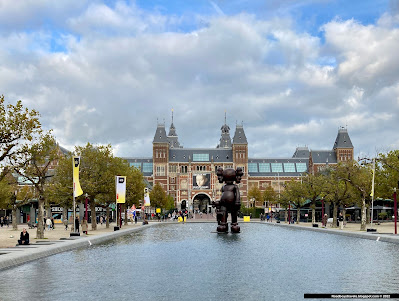Unfinished Business
During a past trip to the Netherlands my daughter and I spent a few days in Amsterdam riding bikes, visiting flea markets, and enjoying the beautiful canal side flower markets.
On that trip though we could not visit Amsterdam's hallowed Rijksmuseum as it was in the midst of an epic and very tortuous decade plus restoration effort. After that trip I vowed to return after it reopened.
Then, even when construction was complete, the reopening was delayed for one issue after another. The last was a squabble whether or not to preserve the cycle passage bisecting the building.
Since bikes are a religion in Amsterdam, the cyclists won (Yay!) and the Rijksmuseum finally reopened.
The Festive Forecourt of the Rijksmuseum
Fast forward to May 2020 trip. I had a trip planned to see tulip fields, return to the Rijksmuseum and visit Rotterdam to take in its striking contemporary architecture.
Hard stop Covid.
So this fall, after waving goodbye to my cycle buddy in Spain, I boarded an $80 flight to Schipol.
Upon landing I immediately realized the Dutch had a very laissez faire attitude regarding Covid (i.e. there wasn't really any precautions noticable?) This was a shock after our time in Spain where people were wonderfully courteous about distancing and masking.
All that said though I'm lucky I was there when I was, as three weeks later Holland had to close again due to its (duh?) surging Covid infection rates. You reap what your sow (just ask America as we pass the tragic milestone of a million documented Covid deaths while idiots argue on their deathbeds about their right to remain unvaccinated). So much for doing the right thing for the good of society.
This trip I spent an entire day immersed in the Rijksmuseum before traveling on to Rotterdam (the tulips part of the trip will have to wait for some other trip).
Here is a small selection of some of Roadboy's favorite images from the Rijksmuseum.
French Prince
(terra cotta 1555-1560)
Note the youthful and mischievous attitude of this future king captured in this sculpture. It is assumed to be Henry III at about age 9. The son of King Henry II and Catherine de Medici this prince was known as a bit of an 'enfant terrible.
The Maritime Model Room
The basement maritime hall was high on my list of favorite exhibits in the museum. It showcases the incredible technical maritime skill of the Dutch in exquisitely detailed models of their ships and even the prefabricated lighthouses the Netherlands once produced and shipped worldwide.
Details of the Ship Models
Heading into the museum's grand halls I spent some awestruck moments just watching conservators performing a painstakingly detailed technical analysis of Rembrandt's most famous painting "The Night Watch". The painting is being analyzed using x-rays, digital analysis, and AI in hopes to accurately determine how it may have looked before it was trimmed 300 years ago to be installed in Amsterdam's Town Hall.
The Night Watch Analysis Team
The Militia Company of Captain Roelof Bicker
Bartholomeus van der Helst, 1643
This enormous (7.5 M long) painting celebrated a military militia in a somewhat loosely structured manner. The painter even included himself in the painting. In the very center of the painting is Captain Roelof Bicker. Interestingly, almost concealed under him is his red caped African "servant". Sadly, the inclusion of the enslaved African child was not out of respect, instead it was meant to symbolize Bicker's wealth. Interesting is how the hypocrisy of the time is overtly portrayed in a painting when, at that very time, the law in Amsterdam stated "Within the City of Amsterdam, and its areas of law, all men are free, and none are slaves".
Servant or Slave?
With the Dutch being a major player in the global slave trade, the museum has appropriately added notes describing Holland's role in shameful exploitation of human lives.
Elaborate Doll Houses
In the late 17th and early 18th century wealthy women in Amsterdam enjoyed the fad of commissioning wildly spectacular doll houses. Many of these elaborate doll houses cost as much as the real mansions they lived in. Now these models offer a pretty accurate glimpse into the homes of a long past era.
Doll House "Nursary" Detail
I really appreciated many of the sculptures in the museum. This one was likely the last major sculpture of Hans Hilger. Cast in the 1626, the loose, spontaneous pose of this piece is considered centuries ahead of its time. Bacchant likely originally shouldered a long since lost globe.
Bacchant
Portrait of Rembrandt van Rijn
Jan Lievens 1628
This portrait of Rembrandt was painted by his friend and studio mate Jan Lievens. Lieven's imitated Rembrandt's style of dark backgrounds and tiny scratches in the paint (to give Rembrandt's neck scarf its texture).
David's Famous Slingshot
The Death of Pharaoh's Firstborn
Lawrence Alma-Tadema 1872
The highly stylized portrait of a grief stricken Pharaoh drew me from across the room. It portrays Moses and Aaron (top right) visiting Pharaoh after his son has died from the plagues sent to convince Pharaoh to let Moses and his people escape Egypt.
Government Opium Presentation Box
Beside the sin against humanity engaging in the global slave trade, the museum presents this chilling sales presentation box. It demonstrates the quality of the opium product's the Dutch pushed in its Imperialist expansion into the Dutch East Indies. Private opium trading was illegal as the government retained a total monopoly on its extremely profitable manufacture and sale.
Self Portrait Vincent van Gogh
Vincent van Gogh 1887
One of Van Gogh's self portraits painted using oil on cardboard. The self portraits reflect poverty rather than vanity as he had little money to pay for models.
Roadboy's Travels © 2022


















No comments:
Post a Comment